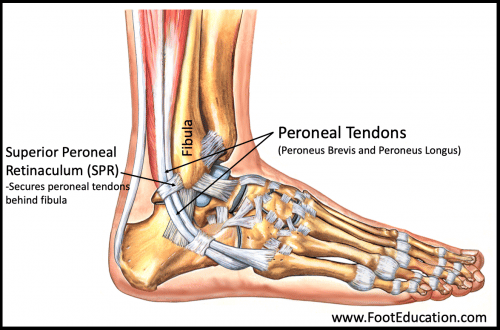Peroneal Subluxation frequently affects athletes but can happen to anyone. It is often caused by a quick, upward flexing or outward rotation of the ankle.
Foot and ankle pain should be taken very seriously. If you are experiencing severe pain in the foot or ankle due to a sports injury, a fall, a car crash, or any other reason, you should make an appointment to see a Podiatrist as soon as you can.
The peroneal tendons stabilize the foot and ankle as they support weight, preventing sprains and other ailments. Each foot has two peroneal tendons that run parallel to one another behind the outer ankle bone. One peroneal tendon connects the baby toe to the midfoot’s outside, while the other peroneal tendon goes beneath the foot and connects to the inside of the arch.
Your doctor will decide if your diagnosis will require surgery or just physical therapy.
Peroneal Subluxation Warning Signs
Have you ever experienced instability or “giving way” in your ankle? When you walk, do you hear popping or snapping? Is there any associated foot pain or discomfort? Have you experienced lateral ankle sprains or undergone foot or ankle surgery?
If you answered “yes” to any of the questions above, Peroneal subluxation may be the diagnosis. Although it happens frequently to athletes, it can happen to anyone.
The peroneal retinaculum tendons are contained within the same sheath and they travel within a fibular groove (which should allow the tendons to glide easily when walking) as you articulate your legs and feet.
Peroneal subluxation is also known as a “snapping ankle” due to the clicking sound that occurs as the tendons move in and out of the wrong positions. If left untreated, chronic peroneal subluxation can harm the tendons and produce longitudinal rips, which can be uncomfortable for the patient. In the long run, it may potentially result in ruptures and cause pain while walking.
Examples of treatment for this type of foot and ankle pain include a cast or boot for immobilization, an ankle brace to support the tendons, stretching exercises, physical therapy, and NSAIDs for inflammation.
Surgical treatments include:
• Repair of the superior peroneal retinaculum.
• Possible groove deepening.
• Repairing diseased (attenuated) peroneal tendons.
• Repair of longitudinal tears.
What is Peroneal Subluxation?
Peroneal subluxation can result from various causes, but if it goes untreated it can be painful and may even tear the peroneal tendons.
The superior peroneal retinaculum, a fibrous band that stabilizes the peroneal tendons, can elongate, tear, or avulse (separate), causing subluxation (or dislocation) of the peroneal tendons. Any of these injuries will cause tremendous foot and ankle pain.
Peroneal tendon subluxation is a very uncommon injury, and surgery is the main treatment for it. A favorable result is obtained with peroneal groove deepening and retinaculum ligament repair. Physical therapy is needed after most foot and ankle surgeries.
Symptoms of Peroneal Tendon Subluxation
Personal Subluxation may cause the peroneal tendons behind your ankle to shift. When your foot is pointed inward or rotates inward while you are standing on it, you will feel a sharp pain on the outside of your ankle, behind the bone.
This pain can be confused with the Achilles tendon and should be diagnosed by a Podiatrist. Your doctor will check your bones, heel, toes, ligaments, and tendons for injuries, inflammation, and foot pain. In extreme cases, some patients may require surgical treatment.
If you suspect this might be the cause of the pain in your foot whenever you walk, make an appointment with a podiatrist soon.
Other Symptoms related to Peroneal Tendon Subluxation are:
• The peroneal tendons behind your ankle SHIFT as you walk.
• Audible popping or snapping.
• sharp pain on the outside of your ankle.
• Foot and ankle pain while walking.
• Discomfort on the outside of your ankle, behind the bone.
• Restricted range of motion and instability.
Foot and Ankle Pain
If the damage to your foot or ankle is severe, non-surgical treatment may require immobilizing your ankle for four to six weeks in a short-leg cast. Additionally, your doctor might recommend medication. Anti-inflammatories can help reduce discomfort and swelling so you can resume your normal activities.
Physical therapy and stretching will help ensure everything heals correctly. Home remedies or at-home treatments should be avoided as they may cause more harm than good.
Treatment of Peroneal Subluxation in Nashville
If you suffer from any kind of foot and ankle pain, make an appointment today at Cutting Edge Foot and Ankle Clinic. We are your local Podiatrists in Nashville TN, and we treat all types of foot pain and ankle issues, including fungal nail infections, surgical bunion repair, hammertoes, ingrown toenails, infection, tendon pain, ankle discomfort, stress fractures, sprains, even plantar fasciitis. We can help with everything from your Achilles tendon to your big toe!
Make an appointment to see why we’re Nashville’s premiere choice for healing feet and ankles. Our board-certified doctors love pampering your feet, right here in Nashville TN!


